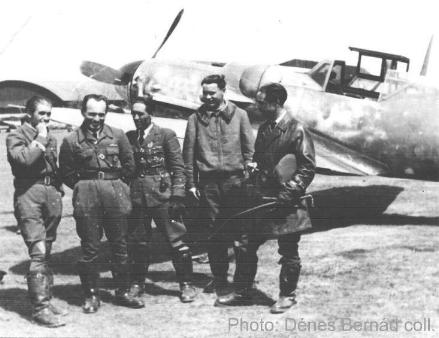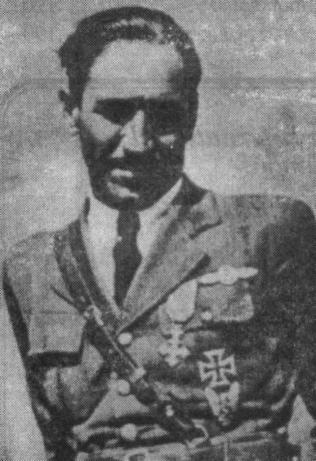|
Ion
Milu

Romanian pilots from the 9th FG on the Tecuci airfield in May
1944. From left: lt Hariton Dusescu, Serbanescu, Milu, adj G Scordila, and
unknown pilot.
Ion Milu was born in Brasov in 1902. At 18 years old he
started the piloting school at Tecuci and entered active service in 1922 as
sergeant aviator. Before the he was a flying instructor, test pilot for
different airplane manufacturing companies and member of different military
commissions. Between others he flew the IAR 80 no. 0 (the prototype) in the
Experiment Squadron at Pipera.
In 1940, adj. maj. Ioan Milu was assigned to
the 7th Fighter Group, which was equipped with the new Bf 109 E. He took part in
the campaign of 1941 and managed to shoot down 3 Soviet airplanes.
The 7th Fighter Group was brought back to
Romania, like the majority of the Romanian troops. They got to the front in
September 1942, in the area around Stalingrad. After the Soviet offensive
started they were encircled, but managed to escape in dramatic conditions.
After reorganization, they were again fighting the Soviets in
Spring 1943, as part of JG 3 "Udet". On 10 April, ten Romanian Bf 109 Gs
attacked the VVS airfield north of Voroshilovgrad. Five Pe-2s were destroyed on
the ground. While the Germans confirmed all the victories, the Romanians
confirmed only two, thus Ion Milu, Nicolae Burileanu and Tiberiu Vinca lost one
each, because of bureaucrats who never saw the front.
Milu shot down a Pe-2 and an Il-2 in the same month and had 5
victories.

On
6 May he hit the jackpot: 3 Soviet airplanes in an epic dogfight. At 3:45, he
took off together with adj. Gheorghe Firu, each with 200 kg of bombs. Their
mission was to bomb an artillery battery. At 2000 m they saw a large formation
of VVS aircraft (18xIl-2 and 20xLa-5) heading towards the airfield. They hurried
up to their destination, dropped the load and then came back. Attacking from
below, Milu forced the Soviets to pull up, thus allowing his comrades to lift
off and join the fight. He shot down one La-5. But ten enemies turned on him. At
4:20 he abandoned the dogfight, after shooting down another two La-5s. He was
loosing fuel, because of a 20 mm shell that perforated a fuel tank.
He was by now serving in the 57th Fighter Squadron (7th
Fighter Group) as of. echip. cls. III, a rank equal to that of slt. (2nd lt.), a
very rare distinction for NCOs. This squadron was under the command of cpt. av.
Alexandru Serbanescu
and included lt. Teodor Greceanu, slt. Constantin Rozariu and adj. Ion Mucenica,
some of the best ARR pilots (these guys had in total about 120 victories by the
end of the war).
On 6 July, a formation under the command of cmdr. Romanescu
took off for a ground attack mission. bur at about 600 m, the commander's engine
caught fire. His cockpit was quickly filled with smoke and he couldn't see
anything. He tried to jump, but was too low. Then Milu came by his side and
guided him until he landed. Because of the shock and of the smoke, cmdr.
Romanescu fainted. Slt. Milu landed near him and dragged him out.
August 1942 was a very good month for the Romanian pilots. Ion
Milu started it with Yak on 4 August and continued with two Il-2s on 7 August.
Milu took off together with cpt. Alexandru Serbanescu,
Lungulescu and Naghirneac. After 20-25 minutes they noticed a formation of Il-2s
escorted by fighters. They surprised them in the moment when they were starting
the attack on the ground forces. After a firing very precise Serbanescu
and Milu sent down four Il-2 (two each). The Soviet fighters retreated with
their remaining assault aircraft.
16 August 1943 was the best day of the 7th Fighter Group. They
had 22 confirmed kills and 5 probable. Of echip. cls. III was the champion of
the day with five: 2xB-8 and 3xIl-2. This is the biggest number of victories
obtained in one day by a Romanian pilot. But his joy was short-lived. He
received news from home that his wife, to whom he had been married from 1930,
died a month ago. Now his daughter's chances of becoming an orphan increased.
But his skill and probably some luck, kept him alive until the of war.
On 19 August, Milu took off together with Adj. Gheorghe Firu
for a third mission. They were joined by lt.Ion Dobran and adj. Moldoveanu.
They had to escort a Romanian Hs-129 formation. They were jumped by four Yaks.
Milu quickly sent one down in flames. But 8 LaGGs appeared. Milu and his wingman
(Firu) engaged them and left the Yaks to the rookies. Even though outnumbered 4
to 1, they stuck to the Henschels. Seeing that they couldn't get to the assault
aircraft, the Soviets turned on the fighters. They managed to corner adj. Firu
and Milu came to his aid. But soon he saw that he wasn't dealing with amateurs.
Behind him was a Soviet with a white nose and a flower on the fuselage and heard
bullets hitting his aircraft. He dived with 7 Soviets on his tail, trying to
evade their shots. He finally reached friendly lines and crash landed his
airplane, which by now looked more like a Swiss cheese, than like an aircraft.
The next day, gen. Dessloch, the commander of Luftflotte IV,
was awarding him the Iron Cross, 1st class. Ten days later, he received the
highest Romanian military honor: the "Mihai Viteazu" Order, 3rd class.
In October 1943, the 9th Fighter Group replaced the 7th
Fighter Group on the front. But some of the pilots remained. Between them was
also Ion Milu. After the reorganization of this group, he was in the 56th
Fighter Squadron.
By spring 1944, the war had reached Romania's borders and the
9th Fighter Group had to fight harder, because there was more in stake now. On
15 April Milu shot down one DB-3 and on 17 one Il-2.
On 24 May, Milu scored his 30th victory. He took off from the
Tecuci airfield and intercepted a DB-3 at 6500 m. He shot it down. When he went
to the crash site with a liaison airplane to confirm his claim, they found the
machine-gunner, who surrendered without resistance. The 31st victory came six
days later, on 30 May. Cpt. Serbanescu,
Milu and Mucenica were escorting some Romanian Ju-88s. They were attacked by
6xP-39s. The fighters intervened and slt. Ion Milu closed up on a Soviet and
fired. Mucenica also bagged one, but after some difficult maneuvering.
From 6 June, the 9th Fighter Group was also flying missions
against the USAAF raids. On 11 June they succeeded in shooting down 5xB-17s.
Milu was one of the victors. This was his first American. The second one came on
15 July and was also a B-17 and the third one on 31 July and was a P-38.
Another battle with the overwhelming forces of the USAAF took
place on 8 August. Cpt. Constantin Cantacuzino lead the 18 airplanes the 9th
Fighter Group sent to confront the invaders. They attacked the bombers twice.
Milu managed to shoot down one P-38. Immediately after that he saw a formation
of 40 Mustangs diving towards the Group. He alerted the others and tried to
evade the Americans, but it was too late. His controls weren't responding
anymore. He dislocated his shoulder when he opened the cockpit. Milu managed to
jump and open his parachute. His was found later that day and taken to the
hospital at Doicesti.
He came back on the front in February 1945 with the 1st
Fighter Group, but until the end of the war he didn't obtain any new victories.
After the war, several Romanian pilots reportedly took part in
a large Allied-organized air show at Wiener-Neustadt on 1 June 1945. These
airmen were asked to represent the German techniques and equipment, including
the Bf-109G6, and provide a comparison to the latest US and Soviet aircraft
types. On the way back to Miskolc, of. echip. cls. III Milu flew together with
lt. av. Dumitru Baciu. Over Hungary, they met several P-51Ds and waggled their
wings as a recognition sign. The Mustangs waved back when the aircraft passed
each other. A Soviet Il-2 formation, escorted by Yak-3s, came along a few
minutes later. The Romanians again waggled their wings, however, the Soviets did
not wave back and flew on in the opposite direction. The last two Yaks suddenly
broke formation and jumped on the two "Gustavs". Milu had enough of the war
(five years) and decided not to engage the aggressors. So he dived to safety.
Lt. av. Baciu apparently managed to shoot down one Soviet and returned home with
16 holes in his aircraft.
In May 1946 he received the swords for his "Mihai Viteazu"
Order, 3rd class.
In 1949 he was already captain and was again test-pilot at IAR
(now a tractor factory called "Sovromtractor"). On 12 May 1940 he took off with
the IAR-811 prototype for the first time. In 1950 he was testing the IAR-813.
In 1980 he died in the city were he was born 72 years before.
He was the third ranking Romanian ace of WWII with 45 confirmed victories and 6
probable.
|
